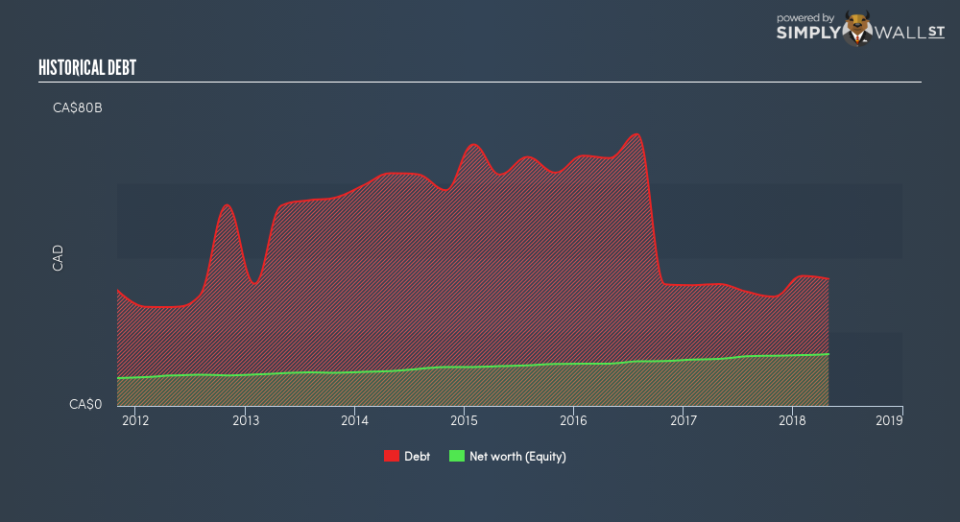Can National Bank of Canada (TSE:NA) Survive The Next Financial Crisis?

National Bank of Canada (TSE:NA) is a large-cap stock operating in the financial services sector with a market cap of CA$22.18b. As major financial institutions return to health after the Global Financial Crisis, we are seeing an increase in market confidence, and understanding of, these “too-big-to-fail” banking stocks. A set of reforms called Basel III was imposed in order to strengthen regulation, supervision and risk management in the banking sector. Basel III target banking regulations to improve the sector’s ability to absorb shocks resulting from economic stress which may expose financial institutions like banks to vulnerabilities. NA operates predominantly in CAD and is held to stringent regulation around the type and level of risk it can take on, exposing it to higher scrutiny on its risk-taking behaviour. We should we cautious when it comes to investing in financial stocks due to the various risks large banks tend to face. Today we will analyse some bank-specific metrics and take a closer look at leverage and liquidity.
Check out our latest analysis for National Bank of Canada
Why Does NA’s Leverage Matter?
Banks with low leverage are exposed to lower risks around their ability to repay debt. A bank’s leverage can be thought of as the amount of assets it holds compared to its own shareholders’ funds. While financial companies will always have some leverage for a sufficient capital buffer, National Bank of Canada’s leverage ratio of 18.29x is significantly below the appropriate ceiling of 20x. This means the bank has a sensibly high level of equity compared to the level of debt it has taken on to maintain operations which places it in a strong position to pay back its debt in unforeseen circumstances. Should the bank need to increase its debt levels to meet capital requirements, it will have abundant headroom to do so.
How Should We Measure NA’s Liquidity?

Since loans are relatively illiquid, we should know how much of the bank’s total assets are comprised of these loans. Generally, they should make up less than 70% of total assets, which is the case for National Bank of Canada’s ratio at 51.98%. This means slightly over half of the bank’s total assets are tied up in the form of illiquid loans, leading to a sensible balance between interest income and liquidity.
Does NA Have Liquidity Mismatch?
Banks operate by lending out its customers’ deposits as loans and charge a higher interest rate. These loans tend to be fixed term which means they cannot be readily realized, however, customer deposits are liabilities which must be repaid on-demand and in short notice. The disparity between the immediacy of deposits compared to the illiquid nature of loans puts pressure on the bank’s financial position if an adverse event requires the bank to repay its depositors. Since National Bank of Canada’s loan to deposit ratio of 80.85% is within the sensible margin, below than the appropriate maximum of 90%, this level positions the bank cautiously in terms of liquidity as it has not disproportionately lent out its deposits and has retained an apt level of deposits.
Next Steps:
National Bank of Canada passes all of our liquidity and leverage checks which shows it is prudent in managing those factors. This gives us confidence in the operational side of the business, an important aspect to consider before investing in the stock. Its high liquidity and low leverage levels mean the bank is well-positioned to meet its financial obligations in the case of any adverse and unpredictable macro events. We’ve only touched on operational risks for NA in this article. But as a stock investment, there are other fundamentals you need to understand. Below, I’ve compiled three essential factors you should further examine:
Future Outlook: What are well-informed industry analysts predicting for NA’s future growth? Take a look at our free research report of analyst consensus for NA’s outlook.
Valuation: What is NA worth today? Has the future growth potential already been factored into the price? The intrinsic value infographic in our free research report helps visualize whether NA is currently mispriced by the market.
Other High-Performing Stocks: Are there other stocks that provide better prospects with proven track records? Explore our free list of these great stocks here.
To help readers see past the short term volatility of the financial market, we aim to bring you a long-term focused research analysis purely driven by fundamental data. Note that our analysis does not factor in the latest price-sensitive company announcements.
The author is an independent contributor and at the time of publication had no position in the stocks mentioned. For errors that warrant correction please contact the editor at editorial-team@simplywallst.com.

 Yahoo Finance
Yahoo Finance 
